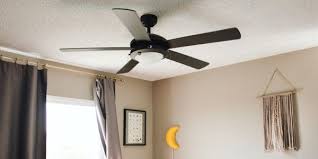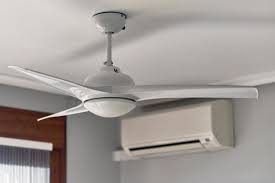Ceiling Fan Blades Impact the Quality and Performance of a Fan
Ceiling Fan Blades
Blades may not be the first thing you think about when shopping for a new fan, but you may be surprised by how much blades affect both the aesthetics and performance of a ceiling fan. Whether you are looking for a new ceiling fan or want to replace an existing fan’s blades, there are several factors to consider. Some blades are created to withstand outdoor environments, while others are meant to lower energy costs inside your home. By understanding the importance of ceiling fan blades, their types, and in which rooms they are suitable, you can make your home’s ceiling fan work for you—and even reduce your cooling costs in the process.
How Many Blades?
There is a common misconception that five ceiling fan blades work better than four or even three blades. Homeowners assume that five blades means better air movement, circulation, and less cooling costs, but in reality, all five blades do is add aesthetic appeal. According to Energy Star more blades do not move more air1 – even one, two, or three bladed fans can be extremely efficient — what matters is the strength of the motor powering the fan.
Blade Span
Blade span refers to the width of a fan, from blade tip to blade tip. The most common ceiling fan blade spans are 52 and 42 inches. Longer blades work best for larger rooms and create softer, more comfortable airflow. Shorter blades offer more direct airflow and are ideal for smaller rooms. The volume of air is not determined by blade span, but by the motor. A motor with smaller blades will move a greater quantity of air than the same motor with larger blades.
Blade Types
For general, in-home use, many ceiling fan blades are made from particleboard or medium-density fiberboard (MDF). High-quality ceiling fan blades, on the other hand, are made from furniture-grade, real hardwood, many with hand-carved intricate designs. Regardless of the material from which they are made, blades come in a wide variety of colors, patterns, and styles to match any room’s décor. If you are shopping for a fan that will be used outdoors, you will want to look for fans with damp or wet-rated ceiling fan blades.

What are the signs of a fan needing replacement?
As I’ve mentioned, there’s no definite things to tell you that you have to replace it. But initial signs of the following deserve to be looked into:
- Annoying buzzes that develop after a few years. This is due to either sub-standard capacitors or poor quality motor windings and laminates.
- Wobbling – a properly installed fan should never wobble. This is a sign of an inferior hanging device or unbalanced blades.
- Squeaky sound of the fan even after oiling.
- Diminishing speed.
- Recurring technical issues even after a professional fix.

How to choose a ceiling fan size
Fan diameter for room size
The amount of air circulated by a ceiling fan is determined by its diameter. Larger rooms require fans with larger diameters, while smaller spaces require fans with smaller diameters:
Small rooms
100 square feet or less work best with a small ceiling fans that range from 30 inches to 48 inches. Small diameter fan sizes are ideal for home offices and laundry rooms.
Large rooms
400 square feet or less work best with medium ceiling fans that range from 48 inches to 54 inches. Medium diameter fan sizes are ideal of living rooms, bedrooms, and kitchens.
Great rooms
Over 400 square feet work well with large ceiling fans 56 inches or larger. Large diameter ceiling fans are ideal for open-concept living areas or lofts with ample space.

What is the difference between 4-blade and 5-blade ceiling fans?
The main difference between a 4- and 5-blade ceiling fan is one of aesthetics and personal taste. However, the laws of physics do dictate a slight difference in performance between ceiling fans with different numbers of blades.
As a rule, as the number of blades goes up, the fan tends to be quieter and circulates less air. Additional blades increase the drag on a ceiling fan’s motor and slow it down. This is one of the reasons why industrial fans (like wind turbines) usually have only two or three blades. They can go faster and move more air, and noise isn’t so much of a concern.
Many ceiling fans designed for the home come standard with four or five blades. Beyond having a pleasing symmetrical aspect, it’s at the 4-blade and 5-blade level that the ideal balance is achieved between the amount of air circulated and amount of tolerable ambient noise.
These days, you are unlikely to notice any major difference in job performance between fans with fewer or more blades. Advancements in overall residential ceiling fan design, balance, and low-drag blade shapes and pitch ensure that ceiling fans with a non-standard number of blades are able to do their job well. Even if you opt for a ceiling fan with an expansive seven blades, you can rest assured it will still perform well.
WHAT IS BLADE PITCH?
Blade pitch is the angle of the blade from the motor. The higher the pitch the greater the movement of air. Are some fans more powerful and quieter? Another key feature to look at when purchasing a fan is motor power. Motors are measured in watts and poles, often indicating how powerful the motor is. The speed of the motor, along with the rest of the design, can have an impact on how the fan operates and the noise it emits. Quieter fans are generally more desirable, however, quiet fans do tend to cost a little more. Direct Current ceiling fans (DC ceiling fans) deliver the ultimate in power and performance. Consuming 75% less electricity than standard ceiling fans, and costing only about 1 cent per hour to run*, while producing better airflow.
*The calculation of costs and savings are approximates only and may vary according to use and size of the fan